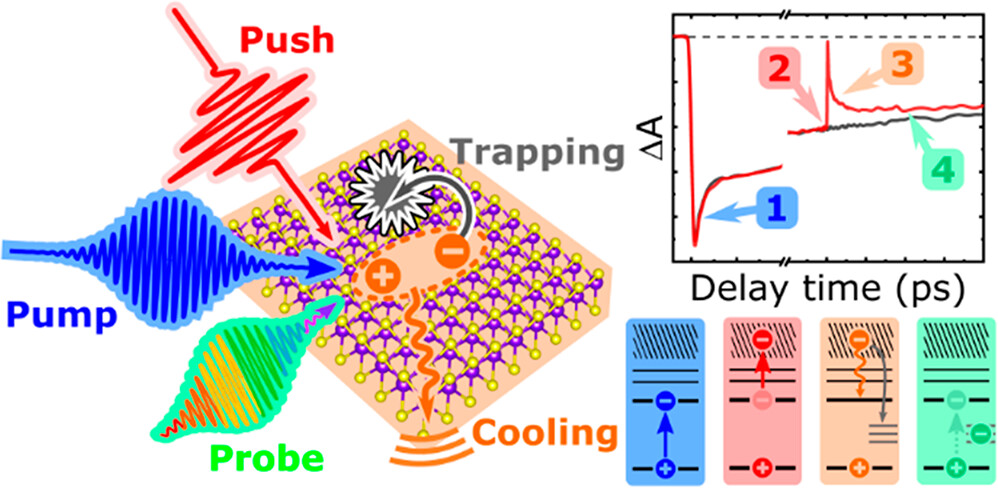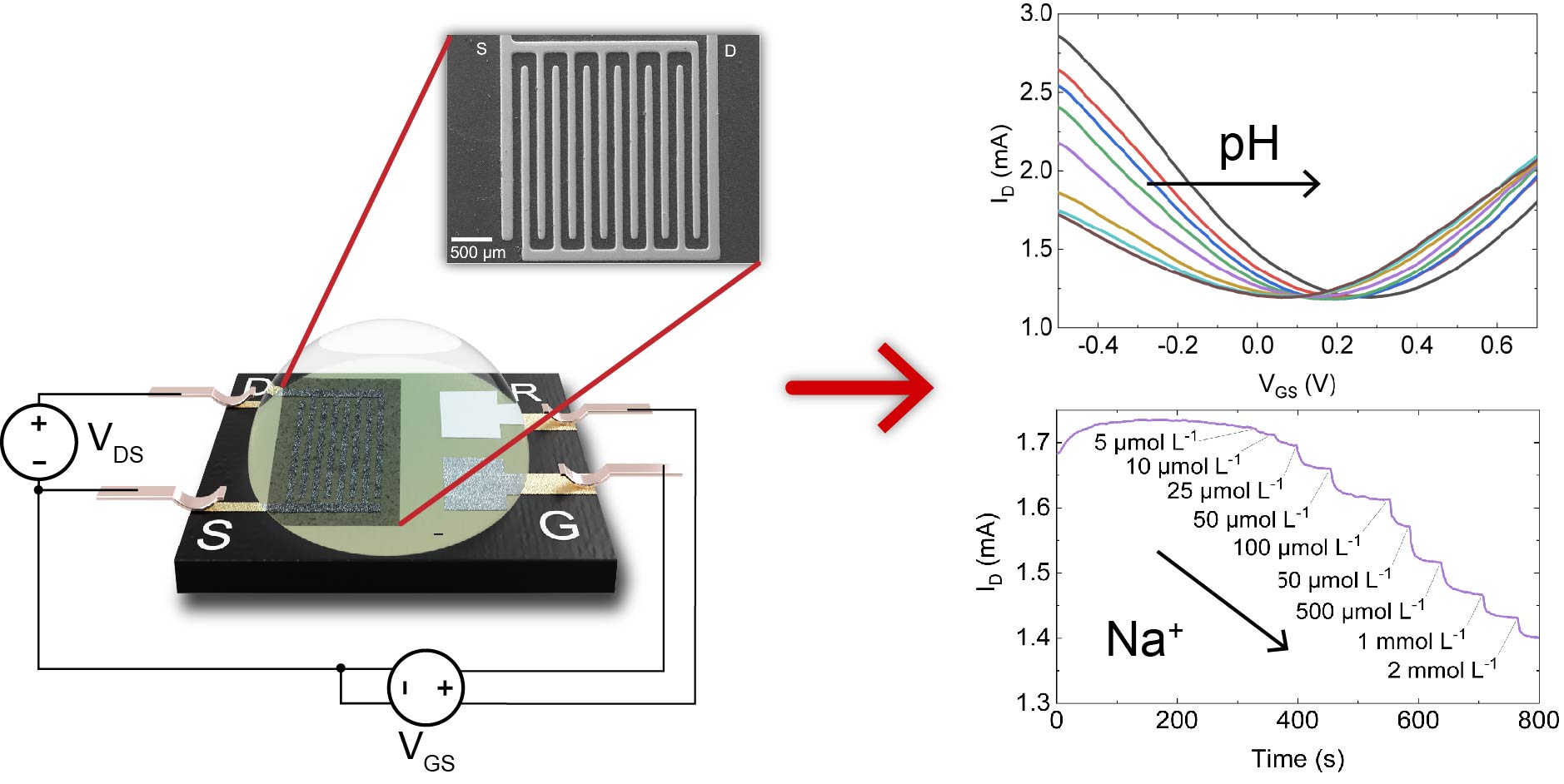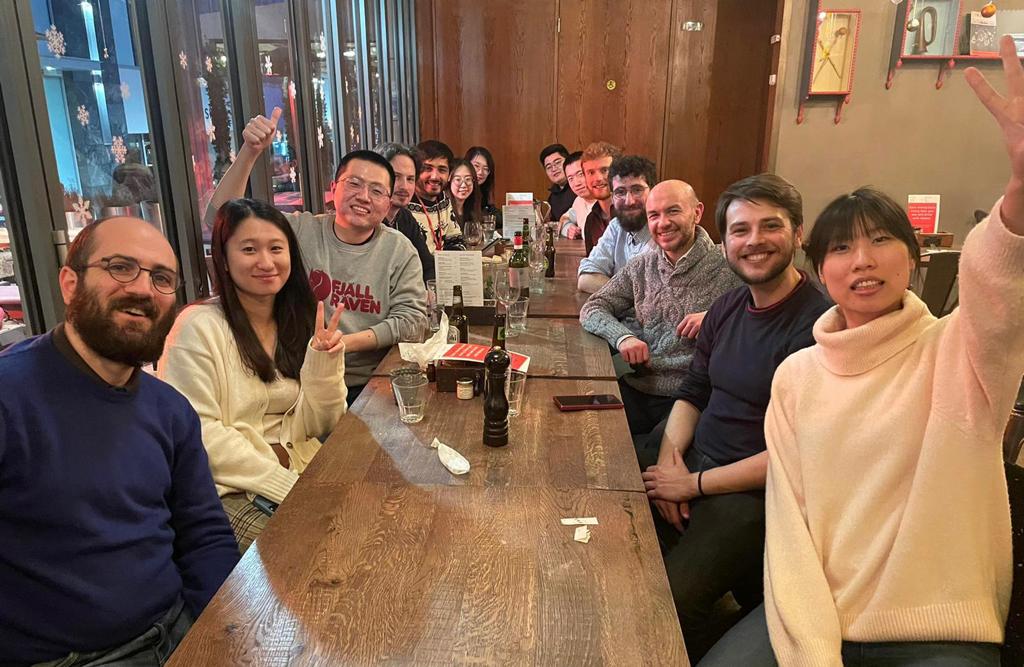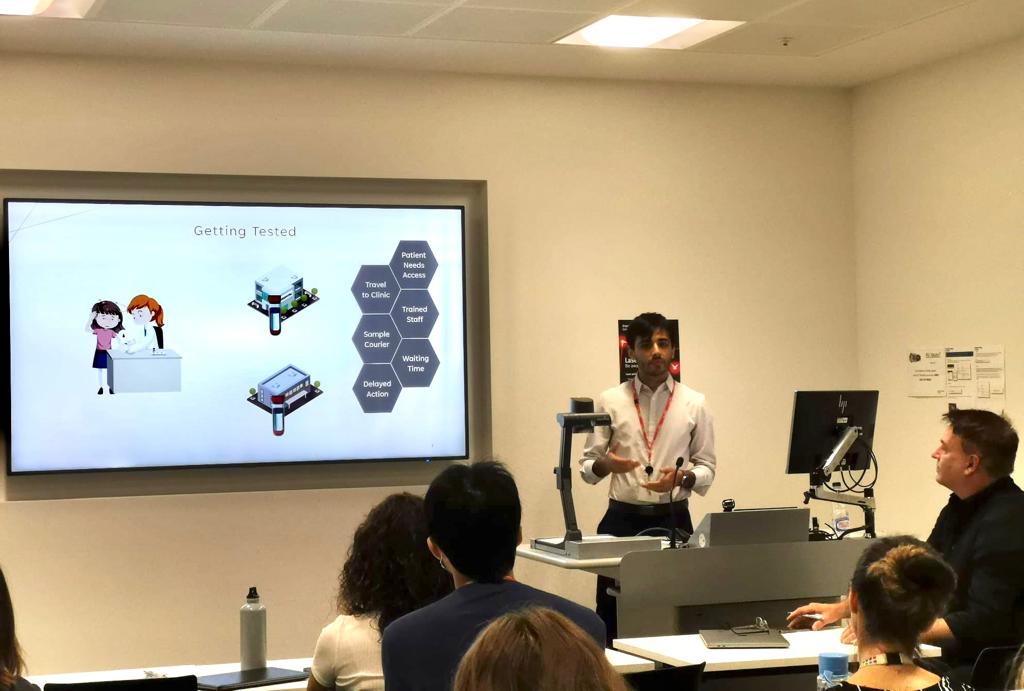March 2025
Dr Felice Torrisi Elected Director of the Centre for Processable Electronics
 The Management Board of the Centre of Excellence for Processable Electronics has elected Dr Felice Torrisi as the new Centre director. Dr Felice Torrisi succeeds Prof. James Durrant, who directed the Centre for the last ten years.
The Management Board of the Centre of Excellence for Processable Electronics has elected Dr Felice Torrisi as the new Centre director. Dr Felice Torrisi succeeds Prof. James Durrant, who directed the Centre for the last ten years.
Felice takes the lead of the CPE after serving on the management boards of the Institute for Digital Molecular Design and Fabrication – DigiFAB, and of the Cambridge Graphene Centre, and as the director of the MRes in Graphene Technology at the University of Cambridge.
Dr Martin Holicky Wins 2024 Chemistry Department PhD Prize

We are delighted to announce that Dr Martin Holicky has been named one of three winners of the Chemistry Department PhD Prize for 2024! This award recognises Martin’s outstanding research on graphene-based microneedle biosensors during his PhD. Congratulations to Martin on this well-deserved achievement!
January 2025
Congratulations to Sihui Liu on Passing Her Viva!

We are delighted to congratulate our PhD candidate Sihui Liu on successfully defending her PhD thesis, "Fibre-Based Electronics and Electronic Textiles with Two-Dimensional Materials", on 28 January 2025. Congratulations, Dr. Liu!
December 2024
Shuwei Wu Presents Cutting-Edge Biosensor Research at MRS 2024

We are delighted to share that our senior PhD candidate, Shuwei Wu, presented at the 2024 Materials Research Society (MRS) Fall Meeting & Exhibit in December in Boston, USA. Shuwei's presentation showcased our latest advancements in biosensors utilising functionalised MoS₂ and cross-linked MXene, paving the way for promising applications in biosensing technology.
We congratulate Shuwei on his achievements!
Christmas Dinner 2024

Our group enjoyed a warm and festive Christmas dinner at Bill's - Westfield on 21 November 2024. Coming together to celebrate our accomplishments made the evening truly special and memorable!
A sincere thank you to George Hawkins for organising such a wonderful event.
November 2024
Publication - Ultrafast Carrier and Lattice Cooling in Ti₂CTₓ MXene Thin Films

Metallic MXenes are promising two-dimensional materials for energy storage, (opto)electronics, and photonics due to their high electrical conductivity and strong light–matter interaction. Energy dissipation in MXenes is fundamental for photovoltaic and photothermal applications. Here we apply ultrafast laser spectroscopy across a broad time range (femto- to microseconds) to study the cooling dynamics of electrons and lattice in emerging Ti₂CTₓ thin films compared to widely studied Ti₃C₂Tₓ thin films. The carrier cooling time in Ti₂CTₓ is persistently ∼2.6 ps without a hot-phonon bottleneck. After hot carrier cooling is completed, the transient absorption spectra of Ti₂CTₓ MXene can be described well by the thermochromic effect. Heat dissipation in MXene thin films occurs over hundreds of nanoseconds with thermal diffusivities ∼0.06 mm² s⁻¹ for Ti₂CTₓ and ∼0.02 mm² s⁻¹ for Ti₃C₂Tₓ, likely due to inefficient interflake heat transfer. Our results unravel the energy dissipation dynamics in Ti₂CTₓ films, showcasing potential applications in energy conversion.
For more details, please find our publication here: Ultrafast Carrier and Lattice Cooling in Ti₂CTₓ MXene Thin Films
September 2024
Congratulations to Chengning Yao on Passing Her Viva!

We are thrilled to congratulate our PhD candidate Chengning Yao on the successful defence of her PhD thesis, "Two-Dimensional Material Composites for Thermal Management and Energy Storage", on 24 September 2024. Well done, Dr. Yao!
Chengning Yao won Young Researcher Award at E-MRS 2024
Congratulations to Chengning Yao, our senior PhD student, who has been awarded the Young Researcher Award at the European Materials Research Society (E-MRS) 2024 Fall meeting.
Congratulations to Martin Holicky on Passing His Viva!
We are delighted to congratulate our PhD candidate Martin Holicky on successfully defending his PhD thesis, "Development of Microneedle Graphene Field-Effect Transistor Biosensors", on 6 September 2024. Congratulations, Dr Holicky!
August 2024
Dr. Chengxing Lian Presents on Graphene Biosensors at IMRC 2024
We are pleased to share that our postdoctoral research associate, Dr Chengxing Lian, recently attended the 32nd International Materials Research Congress (IMRC 2024) in Cancún, Mexico, where he presented our latest advancements in graphene biosensors. Dr Lian’s presentation, "Advanced Graphene Lab-on-PCB Platform for Multi-Ion Biochemical Sensing," showcased our team’s innovative work in 2D-material sensor technology. The platform leverages graphene’s unique electrical properties and a lab-on-PCB design, making it a promising solution for next-generation biochemical analysis and diagnostics.
We congratulate Dr Lian on this achievement and look forward to further advancements in this field.
July 2024
Publication - Thermally Conductive Hexagonal Boron Nitride/Polymer Composites for Efficient Heat Transport

Commercial thermally conductive dielectric materials used in electronic packaging typically exhibit thermal conductivities (κ) ranging from 0.8 to 4.2 W m⁻¹ K⁻¹. Hexagonal boron nitride (h-BN) flakes are promising thermally conductive materials for the thermal management of next-generation electronics. These electrically insulating yet thermally conducting h-BN flakes can be incorporated as thermal fillers to impart high κ to polymer-based composites. A cellulose-based composite embedded with few-layer h-BN (FLh-BN) flakes, achieving a κ ≈ 21.7 W m⁻¹ K⁻¹, prepared using a cost-effective and scalable procedure is demonstrated. This value is >5 times higher than the κ observed in composites embedded with bulk h-BN (Bh-BN, κ ≈ 4.5 W m⁻¹ K⁻¹), indicating the benefits of the superior κ of FLh-BN on the κ of h-BN polymer composites. When applied as a paste for thermal interface material (TIM), the FLh-BN composite can reduce the maximum temperature (Tmax) by 24.5 °C of a heating pad at a power density (h) of 2.48 W cm⁻² compared to Bh-BN composites at the same h-BN loading. The results provide an effective approach to improve the κ of cellulose-based thermal pastes for TIMs and demonstrate their viability for heat dissipation in integrated circuits (ICs) and high-power electronic devices.
For more details, please find our publication here: Thermally Conductive Hexagonal Boron Nitride/Polymer Composites for Efficient Heat Transport
June 2024
Dr Felice Torrisi won Harrison-Meldola Early Career Prize
 Dr Felice Torrisi, from the Department of Chemistry, has won a Harrison-Meldola Early Career Prize for innovative contributions to the understanding of charge transport in networks of two-dimensional materials to develop printed electronics. In addition to this, Dr Torrisi wins £5,000 and a medal.
Dr Felice Torrisi, from the Department of Chemistry, has won a Harrison-Meldola Early Career Prize for innovative contributions to the understanding of charge transport in networks of two-dimensional materials to develop printed electronics. In addition to this, Dr Torrisi wins £5,000 and a medal.
Dr Torrisi's work is groundbreaking in studying the physical mechanisms responsible for electricity transport in printed two-dimensional materials. His research includes using solution processing techniques and electrochemical synthesis to create functional polymer composites and advanced printable and sprayable inks for wearable electronics, quantum computing, and optimising electronic devices.
After receiving the prize, Dr Torrisi said: “I am thrilled to be awarded the Harrison-Meldola Prize. I am grateful to the collaborators and funders who supported my work, and I am so proud of the research group I am working with daily.”
December 2023
Christmas Dinner 2023

Our group celebrated a warm and happy Christmas dinner at Le Petit Citron on 15 December 2023. It was wonderful to see how we've grown into a larger team, making the gathering even more special!
A big thank you to Xinran Li for organising this fantastic event, and a special thanks to Felice for providing the wine.
Publication - Ti₃C₂ MXene as Additive for Low-Cost Textile Supercapacitors with Enhanced Electrical Performance
.jpg)
Textile-based energy storage components are paramount for establishing invisible electronic textiles that do not require conventional rigid batteries. A novel and scalable fabrication method is reported for introducing MXene (Ti₃C₂Tₓ) into activated carbon (AC) supercapacitors to enhance electrochemical performance. Supercapacitors are prepared within a single layer of textile with a phase-inverted polymer membrane fabricated within the textile yarn structure to form a porous, flexible, and mechanically durable separator. MXene is introduced in two different forms: 1) A multilayer MXene (m-MXene) powder is mechanically mixed with an AC slurry and deposited onto the textile. 2) Delaminated MXene (d-MXene) nanosheets are spray-coated onto the surface of spray-coated AC electrode. With an organic electrolyte, 1 M tetraethylammonium tetrafluoroborate in dimethyl sulfoxide, these supercapacitors are electrochemically stable between ±2.6 V and demonstrate a maximum areal capacitance of 148.7 mF cm⁻², an energy density of 0.921 mWh cm⁻², and a power density of 1.01 mW cm⁻². The addition of MXenes improves the areal capacitance, and by combining both approaches, an improvement of 220% is achieved compared with identical supercapacitors with standard AC electrodes. The novelty of this work is to develop a scalable and straightforward solution processing method for introducing MXene into carbon supercapacitor electrodes, enabling high-performance textile-based energy storage devices.
For more details, please find our publication here: Ti₃C₂ MXene as Additive for Low-Cost Textile Supercapacitors with Enhanced Electrical Performance
March 2023
Publication - Hot Carrier Cooling and Trapping in Atomically Thin WS₂ Probed by Three-Pulse Femtosecond Spectroscopy

Transition metal dichalcogenides (TMDs) have shown outstanding semiconducting properties, which make them promising materials for next-generation optoelectronic and electronic devices. These properties are imparted by fundamental carrier–carrier and carrier–phonon interactions that are foundational to hot carrier cooling. Recent transient absorption studies have reported ultrafast time scales for carrier cooling in TMDs that can be slowed at high excitation densities via a hot-phonon bottleneck (HPB) and discussed these findings in light of optoelectronic applications. However, quantitative descriptions of the HPB in TMDs, including details of the electron–lattice coupling and how cooling is affected by the redistribution of energy between carriers, are still lacking. Here, we use femtosecond pump–push–probe spectroscopy as a single approach to systematically characterise the scattering of hot carriers with optical phonons, cold carriers, and defects in a benchmark TMD monolayer of polycrystalline WS₂. By controlling the interband pump and intraband push excitations, we observe, in real-time: (i) an extremely rapid “intrinsic” cooling rate of ∼18 ± 2.7 eV/ps, which can be slowed with increasing hot carrier density, (ii) the deprecation of this HPB at elevated cold carrier densities, exposing a previously undisclosed role of the carrier–carrier interactions in mediating cooling, and (iii) the interception of high-energy hot carriers on the subpicosecond time scale by lattice defects, which may account for the lower photoluminescence yield of TMDs when excited above band gap.
For more details, please find our publication here: Hot Carrier Cooling and Trapping in Atomically Thin WS₂ Probed by Three-Pulse Femtosecond Spectroscopy
January 2023
Publication - A Sprayed Graphene Transistor Platform for Rapid and Low-Cost Chemical Sensing

We demonstrate a novel and versatile sensing platform, based on electrolyte-gated graphene field-effect transistors, for easy, low-cost and scalable production of chemical sensor test strips. The Lab-on-PCB platform is enabled by low-boiling, low-surface-tension sprayable graphene ink deposited on a substrate manufactured using a commercial printed circuit board process. We demonstrate the versatility of the platform by sensing pH and Na⁺ concentrations in an aqueous solution, achieving a sensitivity of 143 ± 4 μA per pH and 131 ± 5 μA per log₁₀Na⁺, respectively, in line with state-of-the-art graphene chemical sensing performance.
For more details, please find our publication here: A Sprayed Graphene Transistor Platform for Rapid and Low-Cost Chemical Sensing
December 2022
Benji Fenech-Salerno Presents His GFET Research at MRS 2022

One of our senior PhD candidates, Benji Fenech-Salerno, recently attended the 2022 Materials Research Society (MRS) conference in Boston, USA, where he presented his latest advancements in 2D-material chemical sensors. Benji greatly valued the opportunity to engage with inspiring talks and stimulating academic discussions at this prestigious conference.
Christmas Dinner 2022

Our group celebrated a warm and joyful Christmas dinner at Balans West on 9 December 2022. Very nice dishes! After the challenges of the pandemic, it was truly special to gather in person, share a meal, and enjoy each other's presence.
A heartfelt thank you to Shuwei Wu for organising this fantastic event.
Publication - Challenges and Opportunities in Free-Standing Supercapacitor Research

The design of commercial supercapacitors has remained largely unchanged since the 1970s, comprising powdered electrodes housed in rigid metal cylinders or pouches. To power the next generation of integrated technologies, an evolution in supercapacitor materials and design is needed to create multifunctional materials that allow energy storage while imparting additional material properties (e.g., flexibility and strength). Conductive free-standing electrodes produced from fibres or 3D-printed materials offer this opportunity as their intrinsic mechanical properties can be transferred to the supercapacitor. Additionally, their conductive nature allows for the removal of binders, conductive agents, and current collectors from the supercapacitor devices, lowering their economic and environmental cost. In this perspective, we summarise the recent progress on free-standing supercapacitors, from new methods to create free-standing electrodes to novel applications for these devices, together with a detailed discussion and analysis of their electrochemical performance and physicochemical and mechanical properties. Furthermore, the potential directions and prospects of future research in developing free-standing supercapacitors are proposed.
For more details, please find our publication here: Challenges and Opportunities in Free-Standing Supercapacitor Research
November 2022
Chengning Yao Wins Best Student Paper at E-Textiles 2022

We are thrilled to announce that Chengning Yao was awarded the Best Student Paper at the E-Textiles 2022 Conference, held in Nottingham in November 2022. Chengning delivered an impactful two-minute pitch alongside an excellent poster presentation, showcasing key findings from her PhD research on the thermal conductivity of h-BN-assisted composites.
July 2022
Benji Fenech-Salerno Wins 1st Prize at 2022 Chemistry PG Symposium

We are delighted to announce that one of our PhD students, Benji Fenech-Salerno, was awarded first prize in the Materials and Molecular Design Session at the Department of Chemistry Postgraduate Symposium held in July at Imperial College London. This recognition was in honour of his exceptional presentation showcasing our latest advancements in biosensor research.
In his work, Benji demonstrated printed graphene field-effect transistor (GFET) biosensors capable of detecting multiple analytes. His research emphasised the use of reliable liquid-phase exfoliation and a repeatable printing technique.
Contact
Dr Felice Torrisi
Senior Lecturer in Chemistry of Two-Dimensional Materials
401A
Molecular Sciences Research Hub
White City Campus
f.torrisi@imperial.ac.uk
+44 (0)20 7594 5818




